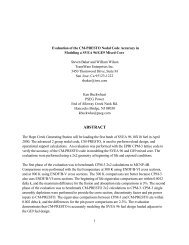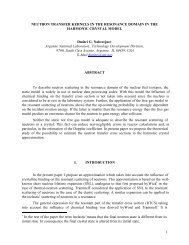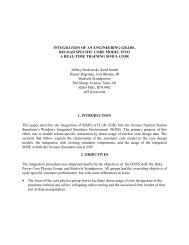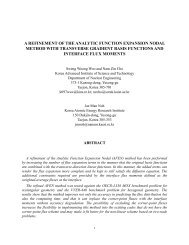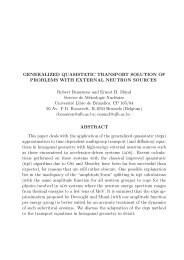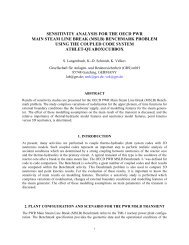Ellis
Ellis
Ellis
Create successful ePaper yourself
Turn your PDF publications into a flip-book with our unique Google optimized e-Paper software.
The thresholds are evident in Figures 6-8 where the lowest-enrichment curve first crosses the<br />
reactivity=0.00 line. The void reactivity becomes positive for midburnup fuel (20 MWd/kgHE)<br />
at the enrichment or MOX loading values tabulated in Table VII. The midburnup state is a good<br />
average representation of the equilibrium operating PWR. The enrichment or Pu-content<br />
thresholds for fresh fuel (solid curves) to have a positive reactivity feedback effect would be<br />
slightly higher than the corresponding midburnup thresholds (dashed curves), for all three fuel<br />
types.<br />
The results presented in Table VII are consistent with the findings of the OECD/NEA benchmark<br />
study of void reactivity effects in PWRs, as discussed in reference 8, which says that “the<br />
inherent void reactivity of MOX assemblies becomes positive somewhere between 10 and 14<br />
w/o total Pu content.” It is important to note that the Pu-content levels being considered for<br />
MOX fuel for Pu disposition are considerably less than the values presented in Table VII.<br />
5. CONCLUSIONS<br />
From the independent assessments of the Island and the full MOX LTA designs by ORNL<br />
(United States) and RRC-KI (Russian Federation), some of the conclusions include:<br />
• there is good general consistency between the results of LTA design assessments by<br />
HELIOS-1.4 (ORNL) and TVS-M (RRC-KI).<br />
• good agreement between HELIOS-1.4 and TVS-M results for the zero-power calculations.<br />
• the temperature reactivity effect (with boron in the coolant) is smaller (less positive, or<br />
negative) for MOX than the reference LEU case.<br />
• furthermore, the temperature reactivity effect is smaller (less positive, or negative) for the<br />
full MOX LTA designs than for the Island LTA designs.<br />
• when the temperature reactivity effect is positive for boronated coolant cases, it is mainly<br />
because of the expansion of the coolant and the resulting reduction in the 10 B concentration.<br />
From the study of void reactivity effects in PWRs for nominal LEU, RG, and WG fuels, some of<br />
the observations include:<br />
• for 10% voiding, the void reactivities for WG and RG are similar, and more negative than<br />
LEU, for fresh fuel.<br />
• for midburnup fuel, for 10% voiding, LEU voiding reactivity is most negative while RG<br />
voiding reactivity is least negative.<br />
• for 100% voiding in fresh fuel, LEU has a much more negative void reactivity effect than<br />
MOX, and RG has the least negative.<br />
• for midburnup fuel, the 100% voiding reactivity effect becomes even more negative in LEU<br />
but becomes somewhat less negative in WG and RG.<br />
From PWR scoping studies for a wide range of LEU enrichments or MOX Pu-content levels, it is<br />
observed that:<br />
• the minimum LEU 235 U enrichment for a positive void reactivity is 20.0 wt%.<br />
• the minimum Pu-content at which RG MOX has a positive void reactivity is 12.4 wt%.<br />
• the minimum Pu-content level for which WG MOX has a positive void reactivity (under<br />
these very unusual conditions) is 12.8 wt%.<br />
9



